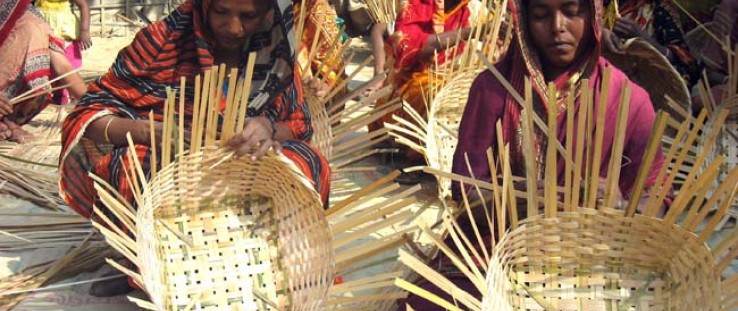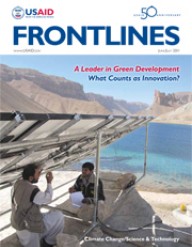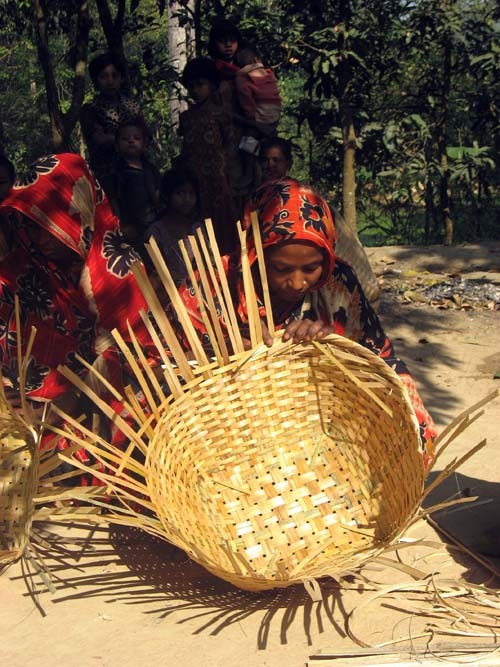 Halima Khatun and her group in Medha Kachhapia make bamboo baskets that pave the way to their financial independence.
Reed Merrill, IPAC
Halima Khatun and her group in Medha Kachhapia make bamboo baskets that pave the way to their financial independence.
Reed Merrill, IPAC
 Halima Khatun and her group in Medha Kachhapia make bamboo baskets that pave the way to their financial independence.
Reed Merrill, IPAC
Halima Khatun and her group in Medha Kachhapia make bamboo baskets that pave the way to their financial independence.
Reed Merrill, IPAC
Three years ago, Halima Khatun was a stay-at-home mother of two, barely scraping by on her disabled husband’s meager income. Though her household was poor, her home deep in the Medha Kachhapia forest was rich in natural beauty—with 12 species of wood plants and about an equal number of herb and shrub varieties. It was a boon for Khatun, but a threat to the fragile forest.
Nearly 10 percent of Bangladesh’s poor rely on forest resources for their survival, Khatun among them. Many of these families have no cultivatable land of their own, and often have been displaced from their original homes and farms by floods or cyclones. With no employment, these people often turn to felling trees from protected forest areas as a source of income. Deforestation releases greenhouse gas emissions into the atmosphere, contributing to climate change, and also reduces the environment’s natural sequestration of carbon by forests.
Khatun was displaced from her original home in Cox’s Bazar, a district headquarter and fishing port in Southern Bangladesh, decades ago due to floods. With her fellow villagers, she started building a new life in the nearby Medha Kachhapia forest, a protected national park in the southeast of the country. Since then, their survival has depended on it.
However, severe encroachment due to expansion of settlements, increased agriculture production, and a host of illegal activities—logging, hunting, shooting, as well as collecting wood, bamboo, cane, and other forest products for fuel—are causing major degradation and contributing to climate change.
Over the last 12 years, USAID has pioneered a “co-management” approach in environmental conservation and management to help people like Khatun gain opportunities for employment and respond to climate change through community-based forest conservation. The initiative brings lawmakers and members of the community together to build resilience to the impacts of climate change and to help create income opportunities for approximately 65,000 people in just the last three years dwelling in or near forests in Bangladesh. The Agency has been promoting co-management to the relevant ministries in the Bangladeshi Government to help mitigate climate change.
Under the scheme, committees of locals and forest officials form around the protected areas to share responsibility for natural resource management and conservation. In Medha Kachhapia, for example, a 21-member Community Patrol Group protects the forest along with official forest guards. USAID also trained the forest-dependent neighborhood to rely increasingly on farmstead agriculture instead.
In 2009, Khatun and 50 other women from her village received training from USAID to makekhareng, a type of basket made of bamboo used for carrying harvested crops, salt, and market vegetables. Bamboo is a fast growing, renewable resource that can be harvested in the homestead and the forest. It is often called the poor man’s timber for its various uses, and it is certainly the case in Medha Kachhapia. The baskets are sold to a local wholesaler.
This model—weaning dependents from the forests, while opening the doors to new opportunities—is being duplicated in 24 more forest protected areas as well as wetlands of Bangladesh.
Today, Khatun is no longer a full-time, stay-at-home mom, earning almost as much as her husband, and, at times, more.
“I can now make up to Tk. 240 [approximately $3.50] a day by weaving kharengs,” she says. “We used to idle away at our house earlier as there was no work; our husbands were often involved in illegal logging due to lack of money, but now we no longer need to turn to the trees, we are financially independent.”
Khatun is now able to afford to send her children to school. She and others in her community are not only more aware of environmental conservation, but now are also a part of a growing market consciousness. “Why should we just sit around when we know now there is a better life waiting for us?” she asks proudly.










Comment
Make a general inquiry or suggest an improvement.